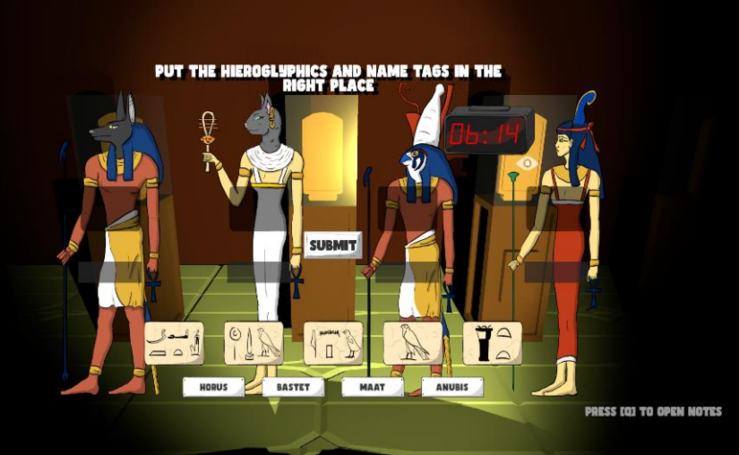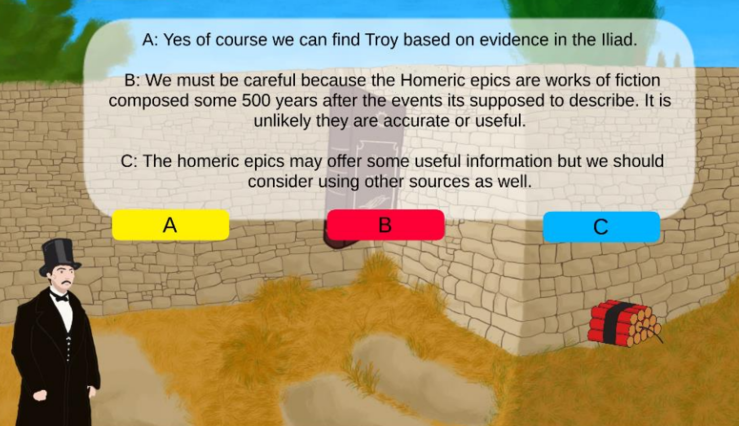Zweite Runde von Digital Storytelling in den Altertumswissenschaften: Roundtable-Gespräch und Workshop (22. November & 8. Dezember 2023)
What do the stories that we can learn by digging up and looking at old things have to do with me? In times of fast-moving media and an oversupply of information, more and more people are asking themselves this question. Digital storytelling is a way of combining scientific knowledge and narration, material objects and virtual worlds not as opposites, but in such a way that the past becomes more accessible and its relevance to the present more tangible. On 22 November 2023, experts at the Institute of Near Eastern Archaeology held a roundtable discussion to find out which approaches have already been tried out in museums, science communication and archaeo-gaming. The event took place as part of the project "Dinge mit Geschichte(n). Digital Storytelling in der altertumswissenschaftlichen Lehre" ("Things with story(s). Digital Storytelling in Ancient Studies Teaching"), funded by the Spotlight Programme of the FU Berlin and the Department of History and Cultural Studies.
Social and technological changes such as a greater sensitivity to diversity, the possibilities of comprehensive in-home entertainment, the Covid-19 pandemic, rapid AI developments and general scepticism towards institutions and the media are increasingly limiting the effectiveness and reach of traditional forms of knowledge transfer. Visits to museums and traditional lectures are no longer appealing when the whole world is accessible at any time via a small device in your hand. "The new public is online," said Chantal Eschenfelder, long-time head of art education at the Städel Museum and the Liebieghaus Skulpturensammlung Frankfurt, in her article "Digital Storytelling in Art Education". With the Städel Stories, digital offerings have been created for many years that complement the encounter with the objects in the preparation and follow-up of a museum visit and are intended to deepen knowledge about contexts and content. Hybrid formats seem ideal, especially as the attention span in the digital space is often only a few seconds and the engagement with the original should not be neglected but intensified. Skilfully used hybridity continues to be a field of experimentation in museum mediation - for the audience as well as for the creators behind it. On the one hand, the applications must be intuitive, but on the other hand they must also highlight the epistemic uncertainties of research.
Katrin Glinka, who works in the Human-Centered Computing group at the Institute of Computer Science at the FU Berlin, showed how this can be achieved using Uncertainty Visualisation, for example, in her input contribution entitled "Design goal: critical reflection". Even small changes such as narrative annotations can significantly improve the understanding of visualisations such as timelines, while modern technologies, such as a HoloLens, literally allow a completely new focus on an object as well as dynamic information transfer (see the mixed reality project Augmenting Viktoria). Such tools should enable new approaches to old things without reinforcing common stereotypes. The task of critically reflecting on epistemic uncertainties in the object sciences must be taken seriously, especially when using AI processes to convey cultural-historical content (see Glinka/Müller-Birn 2023, Critical-Reflective Human-AI Collaboration in Art-Historical Image Retrieval).

Mixed Up Museum, 2023, Studierende der Universität zu Köln
A playful implementation of this is being practised at the University of Cologne with interdisciplinary teams of students from archaeology, archaeoinformatics and digital humanities, initiated in the courses of Sebastian Hageneuer. He explained to us in his lecture "Archaeogaming and teaching. An interdisciplinary course between digital archaeology and digital humanities", he explained that one of the aims of archaeogaming in teaching is the scientific enrichment and correction of the clichéd image of Indiana Jones and other archaeologists who solve puzzles in games in exotic locations, unearth treasures and ultimately destroy everything they can get their hands on. The results, namely playable games, are available open access, so that anyone who wants to can, for example, reorganise a disorganised museum, bring Nefertiti back or re-excavate Troy with Schliemann.
The Schliemann Experience, 2023, Studierende der Universität zu Köln
The concept of the Humboldt-Forums family areas, which were designed by Ute Marxreiter and presented under the title "Digital storytelling in the family areas of the Ethnological Museum in the HUF: indigenous and African perspectives", is hybrid again. The inspiration for this came from indigenous stories that are told in the Amazon, among other places, while lying in hammocks at dawn. This storytelling, indigenous storytelling, is used by the community to impart knowledge and moral concepts. Indigenous people also tell stories in audio installations in the ethnological exhibition, while interactive forest areas invite visitors to become protagonists themselves in humorous but also thought-provoking stories, such as on the subject of deforestation.
You also become a protagonist in a completely new way when you are allowed to carry one of 100 pieces of a replica of the three-hundred-year-old dragon carpet from the Museum of Islamic Art with you until the museum reopens its doors after the renovation in a few years' time. Farwah Rizvi us how this project came about in "Islamic-Art/STORIES. When a door closes...". The kite carpet is just one of many objects that have their own STORIES on the museum's online portal.
All diese Verwendungen von Digital Storytelling setzen auf Multiperspektivität, soziale Diversität und Reflektion über die eigene Wissens- bzw. Wissenschaftskultur zur Vermittlung von Vergangenheit in der Gegenwart. Sie explorieren das Zusammenspiel von Materialität und Digitalität, der Begegnung mit Dingen und dem Erzählen über diese Dinge durch Bilder und Worte im digitalen Raum.
All of these uses of digital storytelling rely on multi-perspectivity, social diversity and reflection on one's own knowledge and scientific culture to convey the past in the present. They explore the interplay between materiality and digitality, the encounter with things and the narration of these things through images and words in digital space.
How can digital storytelling as a strategy and toolbox also find its place in academic teaching in ancient studies? After the stimulating discussions in the roundtable, we will deal with concrete implementation questions in an internal workshop on 8 December 2023.
We would like to thank all speakers and panellists for the stimulating discussion - and look forward to future exchanges!
Valery Schlegel & Elisa Roßberger
Both events were made possible by funding from the FU Berlin's Spotlight Programme and the Department of History and Cultural Studies.
